
Mary and George Fulk go for a spin in their prototype Mayfly16.
Contents:
Contact info:
Jim Michalak
118 E Randall,
Lebanon, IL 62254Send $1 for info on 20 boats.
Jim Michalak's Boat Designs
118 E Randall, Lebanon, IL 62254
A page of boat designs and essays.
(1Jul05) This issue will present the goings on at the June Rend Lake Messabout. The 15 July issue will repeat the sailboat math essay.
THE BOOK IS OUT!
BOATBUILDING FOR BEGINNERS (AND BEYOND)
is out now, written by me and edited by Garth Battista of Breakaway Books. You might find it at your bookstore. If not check it out at the....ON LINE CATALOG OF MY PLANS...
...which can now be found at Duckworks Magazine. You order with a shopping cart set up and pay with credit cards or by Paypal. Then Duckworks sends me an email about the order and then I send the plans right from me to you.

|
Left:
Mary and George Fulk go for a spin in their prototype Mayfly16. |
|
|
REND LAKE 2005
You wouldn't think that a messabout held in June in Illinois would be affected by a tropical hurricane but such was the case at Rend Lake this year. As you will note in the photos we had on and off rain, overcast and sun, all from a to z as the lake was on the limit of the wet coming up from the Gulf. St. Louis, about 50 miles away, was dry through it all.
Need to thank everyone. Many came from pretty far away. Need to give very special thanks to Max Wawrzyniak who has really become an organizer in this event. He talks up the meet to the point where our attendance is maybe twice what it is before he came on board. He keeps the log of who is there. He does all of the cooking even though he has been on a diet for over a year and never eats anymore for himself. Etc., etc., etc. He says next year he won't make the meet except maybe to stop by since he has a family reunion to attend. (Max, they have the entire rest of the year to have a reunion. Can't they show a little consideration!)
Anyway, on to the show. I get there about noon on Friday with my AF4 (did not get a pic of my own boat). Lots of folks are already there. (One thing I will change next year is to encourage folks to reserve camp sites, something you all know I scoffed at before. The campground has gotten popular with really old folks in motor homes. We had enough sites this year but need to start being a bit careful about this.) Weather as stated was somewhat iffy, maybe 40percent chance of rain each day. Winds were quite nice the entire weekend. Fairly light so everyone could sail safely and yet the non sailing boats had an easy time of it since the waves were small.
I guess first up was Dave Seaberg from the Rockford area. He has a D4 pram which he continues to trick out. Had a roller furling jib made from a fishing reel!

Next up was Steve Heger. I think he is first a kayaker but he had this modified CLC sharpie with a rig made from cast off commercial sails. A long narrow hull with a huge tall sail area and a new sailor at the helm! Good thing the wind was light!
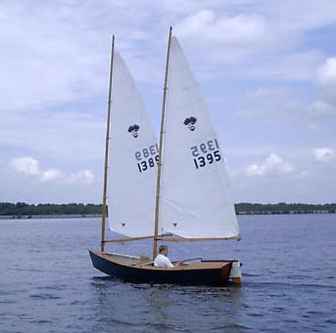
Steve also brought a kayak that he had converted to a sailing trimaran. With three sails and four hulls to attend to he was a busy man.
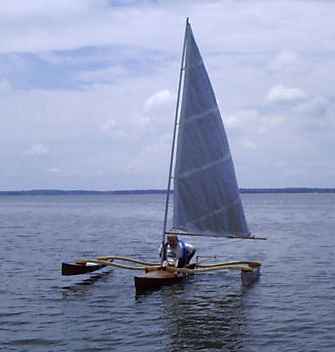
Phillip Reed had a slick looking Bolger Cartopper:
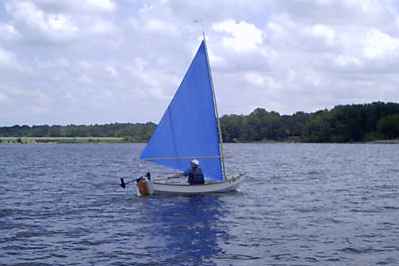
The Skiff America crowd was well represented too with three boats. Kilburn Adams designed it and was there with his prototype, plus Bill Dulin had his. They are all painted alike, like this one by Robert Cope, and you can't tell them apart until you see who is driving:

Chris Feller brought his new AF3 down from Chicagoland. Lug rig was designed for him and is now standard in the AF3 plans packet. Sailed really well. His AF3 also has some built in seats and now that I'm old I see the wisdom in some seats:

Also from Chicagoland is Mike Zenker with his Campanoe. No, it's not a homebuilt but it sure is interesting, made from two stock plastic canoes joined with a center structure complete with coffee table:

Richard Spelling came from Oklahoma with his much traveled and used Bolger light cruiser. (I have stolen a few of his photos to complete this essay.)

And driving all the way from Minneapolis was Mississippi Bob Brown who has authored many stories of his long time boating experiences in that great paper magazine Messing About In Boats. Here Bob has a tortured plywood kayak he designed and built. (I tried to get in this one to take it for a spin but my landing gear would not retract enough to fit into the boat.)

Bob also brought a tortured ply canoe that I mistook for a production glass solo canoe. Here is a Richard Spelling photo of our "beach" on Friday. I am in the foreground with my AF4. The white canoe in the background is Mississippi Bob's.
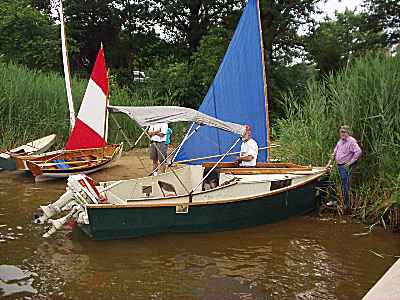
In front of Bob's canoe in that photo is Paul Ellirit's perfect quality Acorn Skiff from Columbia, Mo.. Here is a photo of him sailing along:

Also from Columbia, Mo was Johannes Schel who got enamoured with the double ended jonboats they used to make for drifting on the pretty Rivers of Missouri. Here he is with family on his Dablemont-designed traditional Ozarks paddle jonboat:

Steve Lewis trailered in three boats of his own design, two powerboats and a "scout canoe" which is sort of a simple punt for paddling. Richard Spelling got this photo of his popping one of his power skiffs up on plane.

Motor Max Wawrzyniak brought his AF3 shown here sailing under a lowering sky, plus his Oracle rowing boat (forgot to get a photo of the Oracle).

Max's old motor buddies Jeff Hoesel and Bill Hoevel, who sometimes claim to be brothers and sometimes not, had these oldies. Actually the boat on the right is a newly made old fashioned Glen L design. That on the left is a great Crosby runabout from the late 50's. Max would point out that the Johnson on the right ran like a top all weekend and the Mercury, with it shroud removed for repairs, would not. Instead it only ran at full throttle making for an interesting boating experience.

In the background you can see Rob Rhode-Szudy's Bolger Light Schooner getting ready for its maiden (under sail) voyage. He got it all rigged and he and wife (and two daughters and one really big dog) rowed out of the cove to the main lake. I got this fuzzy photo:

I and Chris Feller followed them out only to see the latest in rain showers sliding in from the South. Chris and I went back into the cove to wait it out beached and under the bimini. But Rob and family pressed on and got really wet. Later in the day as we were cooking supper I saw Rob and schooner gliding across the lake under almost full sail. I don't think anyone got a photo of that but she is indeed a sail boat!
Phil Lea returned again with his ever fast 110% Junebug. Phil is having a messabout of his own in Arkansas later this year.

Speaking of supper, we had a great one again under the white polytarp David Grey donated a year ago. Max cooked it all up!

Thanks again to all! See you next year!
NEXT TIME: We rerun the sailboat math essay.
ROGUE

ROGUE, ROWBOAT, 10' X 3.5', 60 POUNDS EMPTY
I keep trying my hand at these little rowing boats. The idea is that they will cartop very easily, row quite well with one person and take two adults in a pinch. I also try to keep them somewhat seaworthy and easy to beach.
Rogue should be a very good cartop all around rowing boat. I kept her length down to just 10' which should mean that the boat will be short enough to cartop without bumper ties. That gets important because automobiles lost their metal bumpers back in 1990. It will also keep the weight to about 60 pounds for an easy lift to the roof. It should be easier to load than an 8 foot dink because those really short boats often can't be loaded one end at a time - they must be put up there all at once. Even ten footer might be too short for "one end at a time" loading although I know I can load an 11' Piccup Pram that way on a compact car, at least.
I kept the capacity up there at about 400 pounds with lines such that the stem and stern are still out of the water. With a light weight hull that should mean the boat might still row well with two adults. One might ask why longer boats are preferred. First, a longer boat can be faster at any loading because when operated at a low power mode, the speed of the boat is limited by waterline length, the longer the faster. That's because long boats make less waves that short boats and those waves are made by your arms in a rowboat. There are limits to the length, of course, but a really serious racing hull might be 20' long or more for a single seater. (I once saw on a college campus a racing boat for a four man crew, over 60' long as I recall. The rowing coach was trying to recruit men to row it, saying he preferred red shirted basketball players - the bigger and taller the better.) And one might remember that there are other elements that cause drag such as skin friction and windage, both factors get worse as boat length increases.
I went to multichines with Rogue and would expect her to be a good sea boat for the size, at least when rowed solo. (That is another argument for a longer boat. When loaded with a passenger the weight in the boat gets pushed to the ends and in rough water the boat will not lift itself over the waves but instead pushes through them and that usually slows you down. A longer boat is not affected as badly here.) I'm quite certain that a multichine hull has less drag all around than a flat bottomed boat, although I suspect the V is better yet. The multichine hull is a very good compromise in that it will beach flat and have draft somewhere between a flattie and a V bottom, everything else being equal. My first rowboat, Roar, had a hull like Rogue, but was 14' long. I found out from it that a multichine has little resistance to side loads, as in a cross wind. Thus to avoid needing to row in a "crab" in crosswinds, a multichine needs a lot of skeg area and a full length keelson.
Construction is taped seam. Three sheets of 1/4" plywood will do it and only two thirds of that ends up in the boat, the rest used as temporary forms that are removed. No jigs or lofting.
Plans for Rogue arel $15 until one is built and tested.
Prototype News
Some of you may know that in addition to the one buck catalog which now contains 20 "done" boats, I offer another catalog of 20 unbuilt prototypes. The buck catalog has on its last page a list and brief description of the boats currently in the Catalog of Prototypes. That catalog also contains some articles that I wrote for Messing About In Boats and Boatbuilder magazines. The Catalog of Prototypes costs $3. The both together amount to 50 pages for $4, an offer you may have seen in Woodenboat ads. Payment must be in US funds. The banks here won't accept anything else. (I've got a little stash of foreign currency that I can admire but not spend.) I'm way too small for credit cards.
The AF4G is done and launched. Writeup after testing:

Garth has the big Cormorant ready to go but the kids won't give it back.
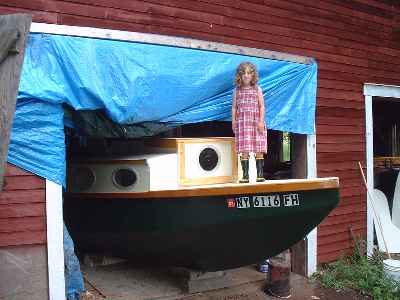
The out West Picara has its roof and some major sail rig bits done:

The down South Picara is getting its innards done.

This long and lean project is a 19' version of Toon2. I'm told this one is more or less complete, left with the 15 % of the work that takes 85% of the time.

Mary and George Fulk have finished their Mayfly16. Report next issue:

This is a slightly modified Veep14. I'm told the sheer is raised a bit and the stern given a bit of flare but the bottom is per the plans. Waiting for a test:

A Vector builder is keeping a website of the project at http://www.geocities.com/michsand@sbcglobal.net/ but in the meantime I got photos of a Vector completed by Pete Mohylsky in Florida. Here he is fussing with his sail. Hopefully a report soon:

And the Polish Polepunt is complete. Just needs water:

AN INDEX OF PAST ISSUES
Hullforms Download (archived copy)
Plyboats Demo Download (archived copy)
Brokeboats (archived copy)
Brian builds Roar2 (archived copy)
Herb builds AF3 (archived copy)
Herb builds RB42 (archived copy)